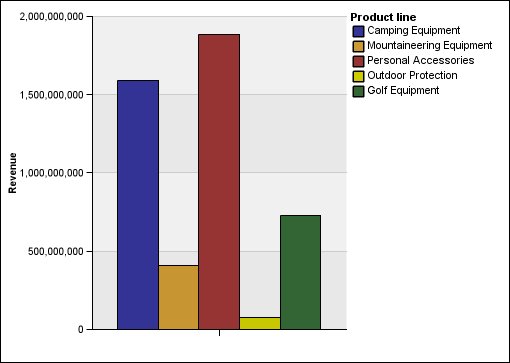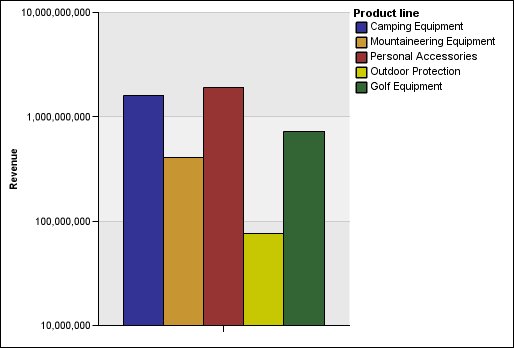Change the Axis Scale of a Current Default Chart
You can specify the following for each axis:
- the maximum and minimum values of the range
- whether to include zero in an automatic axis range
- whether to use a logarithmic scale, if the values in the chart cover a very large range
- how often major and minor gridlines appear
Logarithmic scales can be useful when some of the data you are displaying is much less or much more than the rest of the data or when the percentage or ratio differences between values are important.
A logarithmic scale in Report Studio shows the base value of 10 raised to the power of a value. For example, 10 has a logarithm of 1 because 10 raised to the power of 1 is 10, 100 has a logarithm of 2 because 10 raised to the power of 2 is 100, and so on.
For example, the following chart is using a normal scale:

In this chart, the Y-axis shows values up to 2,000,000,000 with evenly spaced intervals of 400,000,000. However, the Outdoor Protection column is so much less than the other columns that it is difficult to compare them.
The following is the same chart using a logarithmic scale:

In this chart, the Y-axis still shows the same revenue values, but the intervals reflect a logarithmic scale, which increases exponentially. You can now compare all the product lines because none of the product lines have much higher or much lower values than the others.
Logarithmic scales can also be useful when the percentage or ratio differences between values are important. For example, if the logarithmic scale chart above represents data from 2011, and you add data from 2012 as a second set of colored bars, you could see the differences between the 2011 revenue and 2012 revenue. In a logarithmic scale, differences between values on the Y-axis represent the same percentage for each bar. So if the 2011 and 2012 data differs by the same distance for each product line, you could deduce that your revenue went up by the same percentage for each product line. This would not be clear on a normal scale.
